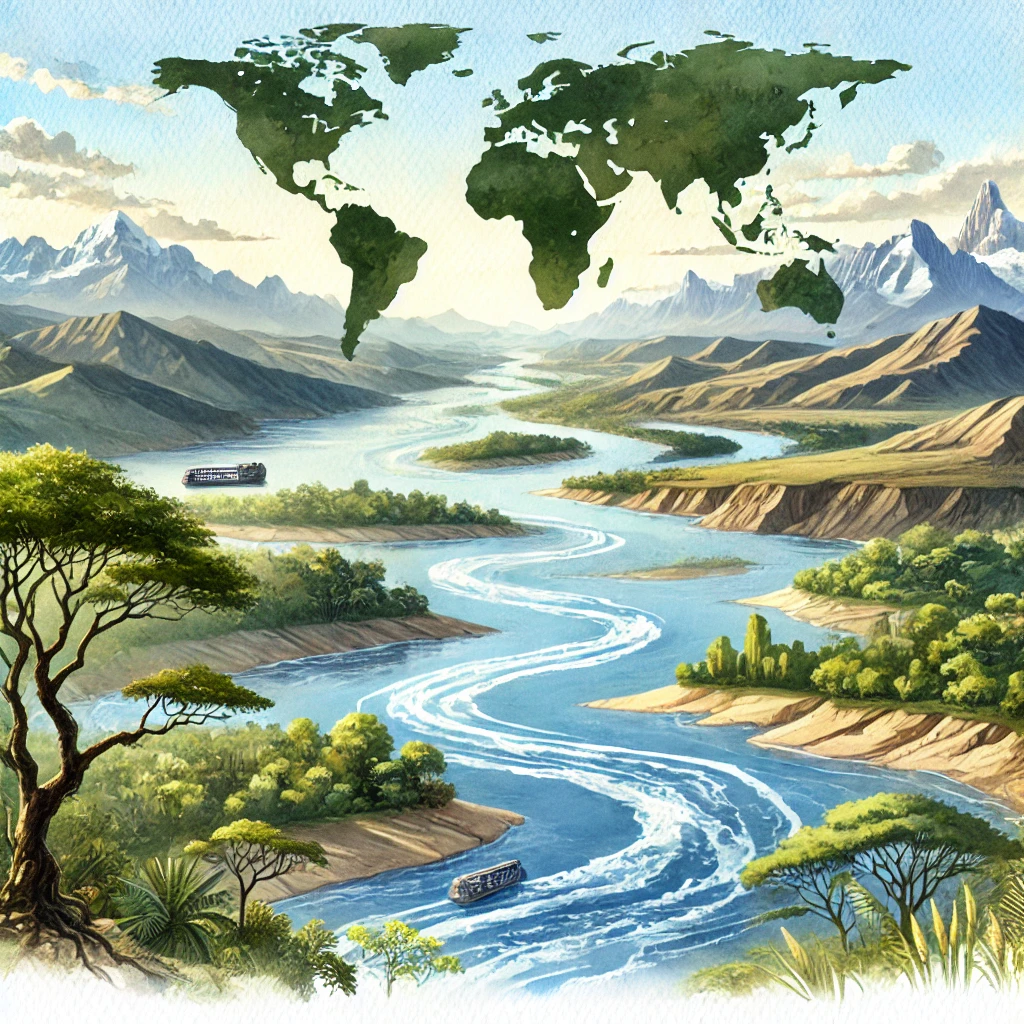Have you ever wondered how rivers, those winding paths of water, shape the land we live on? Well, rivers aren’t just big streams—they’re like nature’s superhighways, carving out mountains, nourishing forests, and giving life to cities and farms. Some rivers are so long they stretch across entire continents, crossing countries and ecosystems along the way!
Imagine this: a river starting high in the snowy peaks of mountains, rushing down into forests, across plains, and out to the ocean. These rivers don’t just help plants and animals—they’ve been the lifeblood of human civilizations for thousands of years. Ancient Egypt, for example, wouldn’t have thrived without the Nile, and the Amazon is still home to one of the richest ecosystems on Earth. Some of these rivers are so wide you could stand on one bank and barely see the other side!
In this list, we’ll journey along the 50 longest rivers in the world. Each one has its own story, flowing through landscapes that are as different as deserts and rainforests. Whether you’re curious about the mighty Nile or the ever-winding Amazon, we’ve got a lot of cool facts to discover. So, grab your explorer’s hat and let’s dive into the flowing wonders of the Earth!
1. Nile River
- Length: 6,650 km (4,130 miles)
- Location: Northeastern Africa
- Countries: Uganda, Sudan, Egypt, Ethiopia, Rwanda, Burundi, and others
- Source: Lake Victoria
- Mouth: Mediterranean Sea
Notable Fact:
The Nile is often considered the longest river in the world, serving as the lifeblood of ancient Egypt and playing a crucial role in African ecosystems.
2. Amazon River
- Length: 6,400 km (4,000 miles)
- Location: South America
- Countries: Brazil, Peru, Colombia, and others
- Source: Andes Mountains
- Mouth: Atlantic Ocean
Notable Fact:
While often ranked as the second longest, the Amazon boasts the largest drainage basin and the greatest volume of water flow among all rivers.
3. Yangtze River
- Length: 6,300 km (3,917 miles)
- Location: China
- Source: Tibetan Plateau
- Mouth: East China Sea
Notable Fact:
The Yangtze is the longest river in Asia and has been a cradle for Chinese civilization for thousands of years.
4. Mississippi-Missouri River System
- Length: 6,275 km (3,902 miles)
- Location: North America
- Countries: United States
- Source: Lake Itasca (Mississippi); Rocky Mountains (Missouri)
- Mouth: Gulf of Mexico
Notable Fact:
This river system, vital to North America, includes the Mississippi River and its major tributary, the Missouri River.
5. Yenisei-Angara-Selenge River System
- Length: 5,539 km (3,445 miles)
- Location: Russia, Mongolia
- Source: Mongolia
- Mouth: Kara Sea
Notable Fact:
This river system drains the central Siberian Plateau into the Arctic Ocean.
6. Yellow River (Huang He)
- Length: 5,464 km (3,395 miles)
- Location: China
- Source: Bayan Har Mountains
- Mouth: Bohai Sea
Notable Fact:
The Yellow River is often called “China’s Sorrow” due to its frequent flooding, which has shaped Chinese history.
7. Ob-Irtysh River System
- Length: 5,410 km (3,364 miles)
- Location: Russia, Kazakhstan, China
- Source: Altai Mountains
- Mouth: Gulf of Ob
Notable Fact:
The Ob River and its tributary, the Irtysh, form one of the major rivers of Siberia, flowing into the Arctic Ocean.
8. Paraná-Rio de la Plata River System
- Length: 4,880 km (3,032 miles)
- Location: South America
- Countries: Brazil, Paraguay, Argentina
- Source: Brazil
- Mouth: Río de la Plata
Notable Fact:
This river system is crucial to agriculture and hydroelectric power in South America.
9. Congo River
- Length: 4,700 km (2,922 miles)
- Location: Central Africa
- Countries: Democratic Republic of Congo, Republic of the Congo, Angola
- Source: East African Rift
- Mouth: Atlantic Ocean
Notable Fact:
The Congo River is the deepest river in the world, with depths reaching up to 220 meters (720 feet).
10. Amur-Argun River System
- Length: 4,444 km (2,761 miles)
- Location: Russia, China
- Source: Eastern Russia
- Mouth: Sea of Okhotsk
Notable Fact:
The Amur forms part of the natural border between the Russian Far East and northeastern China.
11. Lena River
- Length: 4,400 km (2,736 miles)
- Location: Russia
- Source: Baikal Mountains
- Mouth: Laptev Sea
Notable Fact:
The Lena is one of the three great Siberian rivers that flow into the Arctic Ocean.
12. Mekong River
- Length: 4,350 km (2,703 miles)
- Location: Southeast Asia
- Countries: China, Myanmar, Laos, Thailand, Cambodia, Vietnam
- Source: Tibetan Plateau
- Mouth: South China Sea
Notable Fact:
The Mekong River is the lifeblood of Southeast Asia, supporting millions through its fisheries and agriculture.
13. Mackenzie River
- Length: 4,241 km (2,635 miles)
- Location: Canada
- Source: Great Slave Lake
- Mouth: Beaufort Sea
Notable Fact:
This river is the longest in Canada and flows through vast wilderness into the Arctic Ocean.
14. Niger River
- Length: 4,180 km (2,597 miles)
- Location: West Africa
- Countries: Guinea, Mali, Niger, Nigeria
- Source: Guinea Highlands
- Mouth: Gulf of Guinea
Notable Fact:
The Niger River provides critical water resources for agriculture and sustains many communities in West Africa.
15. Brahmaputra River
- Length: 3,848 km (2,391 miles)
- Location: China, India, Bangladesh
- Source: Tibetan Plateau
- Mouth: Bay of Bengal
Notable Fact:
The Brahmaputra is one of the major rivers of the Indian subcontinent, known for its powerful floods.
16. Murray-Darling River System
- Length: 3,672 km (2,282 miles)
- Location: Australia
- Source: Australian Alps
- Mouth: Southern Ocean
Notable Fact:
The Murray-Darling basin is Australia’s most important agricultural region, although the rivers often face severe droughts.
17. Volga River
- Length: 3,645 km (2,266 miles)
- Location: Russia
- Source: Valdai Hills
- Mouth: Caspian Sea
Notable Fact:
The Volga is the longest river in Europe, crucial to Russian transportation and industry.
18. Shatt al-Arab-Euphrates-Tigris River System
- Length: 3,596 km (2,234 miles)
- Location: Middle East
- Countries: Turkey, Syria, Iraq
- Source: Taurus Mountains
- Mouth: Persian Gulf
Notable Fact:
This river system is known as the cradle of Mesopotamian civilization.
19. Indus River
- Length: 3,610 km (2,243 miles)
- Location: South Asia
- Countries: Pakistan, India, China
- Source: Tibetan Plateau
- Mouth: Arabian Sea
Notable Fact:
The Indus River is the primary water source for Pakistan, with a significant impact on agriculture and livelihoods.
20. Zambezi River
- Length: 2,574 km (1,599 miles)
- Location: Southern Africa
- Countries: Zambia, Angola, Namibia, Botswana, Zimbabwe, Mozambique
- Source: Zambia
- Mouth: Indian Ocean
Notable Fact:
The Zambezi is famous for the Victoria Falls, one of the largest and most famous waterfalls in the world.
21. Danube River
- Length: 2,860 km (1,777 miles)
- Location: Central and Eastern Europe
- Countries: Germany, Austria, Hungary, Romania, and others
- Source: Black Forest, Germany
- Mouth: Black Sea
Notable Fact:
The Danube flows through 10 countries, making it one of the most internationally significant rivers in the world.
22. Tocantins-Araguaia River System
- Length: 2,640 km (1,640 miles)
- Location: Brazil
- Source: Central Brazilian Plateau
- Mouth: Atlantic Ocean
Notable Fact:
Though it flows through a sparsely populated area, this river system is crucial for Brazil’s hydroelectric power.
23. Salween River
- Length: 2,815 km (1,749 miles)
- Location: Southeast Asia
- Countries: China, Myanmar, Thailand
- Source: Tibetan Plateau
- Mouth: Andaman Sea
Notable Fact:
The Salween is one of Southeast Asia’s longest free-flowing rivers, known for its unregulated and wild flow.
24. Saint Lawrence River
- Length: 3,058 km (1,900 miles)
- Location: Canada, United States
- Source: Great Lakes
- Mouth: Atlantic Ocean
Notable Fact:
The Saint Lawrence River is a key shipping route linking the Great Lakes with the Atlantic Ocean.
25. Ganges River
- Length: 2,525 km (1,569 miles)
- Location: India, Bangladesh
- Source: Himalayas
- Mouth: Bay of Bengal
Notable Fact:
The Ganges is one of the most sacred rivers in the world, especially revered in Hinduism, and is essential to agriculture and life in northern India.
26. Nelson-Saskatchewan River System
- Length: 2,575 km (1,600 miles)
- Location: Canada
- Source: Canadian Rockies
- Mouth: Hudson Bay
Notable Fact:
The Nelson River system is essential for Canada’s hydroelectric power generation, particularly in Manitoba.
27. Yukon River
- Length: 3,190 km (1,982 miles)
- Location: Canada, United States (Alaska)
- Source: British Columbia, Canada
- Mouth: Bering Sea
Notable Fact:
The Yukon River played a pivotal role during the Klondike Gold Rush and remains crucial for transportation in Alaska.
28. Purús River
- Length: 3,211 km (1,995 miles)
- Location: South America
- Countries: Brazil, Peru
- Source: Andes Mountains
- Mouth: Amazon River
Notable Fact:
The Purús River meanders extensively, with one of the most winding paths of any major river.
29. São Francisco River
- Length: 2,914 km (1,811 miles)
- Location: Brazil
- Source: Canastra Range
- Mouth: Atlantic Ocean
Notable Fact:
The São Francisco River is often called the “river of national integration” due to its importance in connecting diverse regions of Brazil.
30. Volta River
- Length: 1,600 km (994 miles)
- Location: West Africa
- Countries: Ghana, Burkina Faso
- Source: Burkina Faso
- Mouth: Gulf of Guinea
Notable Fact:
The Akosombo Dam on the Volta River forms Lake Volta, one of the world’s largest artificial lakes.
31. Kolyma River
- Length: 2,129 km (1,323 miles)
- Location: Russia
- Source: Kolyma Mountains
- Mouth: East Siberian Sea
Notable Fact:
The Kolyma River is infamous for its association with Soviet labor camps during the Stalinist era.
32. Tapajós River
- Length: 2,430 km (1,510 miles)
- Location: Brazil
- Source: Mato Grosso Plateau
- Mouth: Amazon River
Notable Fact:
The Tapajós River is a major tributary of the Amazon, known for its clear waters compared to the sediment-rich Amazon River.
33. Vilyuy River
- Length: 2,650 km (1,647 miles)
- Location: Russia
- Source: Central Siberian Plateau
- Mouth: Lena River
Notable Fact:
The Vilyuy River is vital to the diamond mining industry in Siberia, as it flows through some of the world’s richest diamond deposits.
34. Peace River
- Length: 1,923 km (1,195 miles)
- Location: Canada
- Source: Rocky Mountains
- Mouth: Slave River
Notable Fact:
The Peace River, along with the Athabasca River, contributes to the Mackenzie River basin, one of North America’s largest river systems.
35. Xingu River
- Length: 2,092 km (1,300 miles)
- Location: Brazil
- Source: Central Brazilian Plateau
- Mouth: Amazon River
Notable Fact:
The Xingu River is home to the Belo Monte Dam, one of the largest hydroelectric projects in the world, though it has faced significant environmental concerns.
36. Seine River
- Length: 777 km (483 miles)
- Location: France
- Source: Côte-d’Or region
- Mouth: English Channel
Notable Fact:
The Seine flows through Paris, making it one of the most iconic rivers in Europe and central to French history and culture.
37. Fraser River
- Length: 1,375 km (854 miles)
- Location: Canada
- Source: Rocky Mountains
- Mouth: Strait of Georgia
Notable Fact:
The Fraser River is known for its significant salmon runs, supporting one of the world’s most productive salmon fisheries.
38. Magdalena River
- Length: 1,528 km (949 miles)
- Location: Colombia
- Source: Colombian Andes
- Mouth: Caribbean Sea
Notable Fact:
The Magdalena River is Colombia’s principal waterway and has been historically vital for transportation and trade.
39. Dnieper River
- Length: 2,201 km (1,368 miles)
- Location: Russia, Belarus, Ukraine
- Source: Valdai Hills
- Mouth: Black Sea
Notable Fact:
The Dnieper is central to the history and culture of Ukraine, forming a major shipping route and source of hydroelectric power.
40. Orange River
- Length: 2,200 km (1,367 miles)
- Location: Southern Africa
- Countries: South Africa, Namibia, Lesotho
- Source: Drakensberg Mountains
- Mouth: Atlantic Ocean
Notable Fact:
The Orange River is a key source of water in the arid regions of South Africa and Namibia.
41. Madeira River
- Length: 3,380 km (2,100 miles)
- Location: South America
- Countries: Bolivia, Brazil
- Source: Andes Mountains
- Mouth: Amazon River
Notable Fact:
The Madeira River is one of the largest tributaries of the Amazon and plays a crucial role in the region’s biodiversity.
42. Orinoco River
- Length: 2,140 km (1,330 miles)
- Location: South America
- Countries: Venezuela, Colombia
- Source: Parima Mountains
- Mouth: Atlantic Ocean
Notable Fact:
The Orinoco River is famous for its biodiversity and its vast delta, which forms a unique environment.
43. Tigris River
- Length: 1,850 km (1,150 miles)
- Location: Middle East
- Countries: Turkey, Iraq
- Source: Taurus Mountains
- Mouth: Shatt al-Arab (joins Euphrates River)
Notable Fact:
The Tigris River, alongside the Euphrates, helped form the Fertile Crescent, the birthplace of some of the world’s earliest civilizations.
44. Rhine River
- Length: 1,230 km (764 miles)
- Location: Western Europe
- Countries: Switzerland, Germany, Netherlands, France, Luxembourg
- Source: Swiss Alps
- Mouth: North Sea
Notable Fact:
The Rhine is one of Europe’s most important rivers, historically serving as a vital trade route.
45. Araguaia River
- Length: 2,627 km (1,632 miles)
- Location: Brazil
- Source: Brazilian Highlands
- Mouth: Tocantins River
Notable Fact:
The Araguaia River is a major tributary of the Tocantins and is known for forming the Bananal Island, the world’s largest river island.
46. Colorado River
- Length: 2,334 km (1,450 miles)
- Location: United States, Mexico
- Source: Rocky Mountains
- Mouth: Gulf of California
Notable Fact:
The Colorado River is renowned for carving the Grand Canyon and provides vital water resources to millions in the southwestern United States.
47. Ganges-Brahmaputra-Meghna River System
- Length: 3,979 km (2,472 miles)
- Location: India, Bangladesh, Tibet
- Source: Himalayas
- Mouth: Bay of Bengal
Notable Fact:
This river system forms the largest delta in the world, the Sundarbans, home to unique mangrove forests and endangered species like the Bengal tiger.
48. Limpopo River
- Length: 1,750 km (1,087 miles)
- Location: Southern Africa
- Countries: South Africa, Botswana, Zimbabwe, Mozambique
- Source: South Africa
- Mouth: Indian Ocean
Notable Fact:
The Limpopo River is famous for its wildlife-rich floodplains and has been described in literature, most notably by Rudyard Kipling.
49. Loire River
- Length: 1,006 km (625 miles)
- Location: France
- Source: Massif Central
- Mouth: Atlantic Ocean
Notable Fact:
The Loire is the longest river in France and is renowned for its picturesque valleys and historic châteaux.
50. Tennessee River
- Length: 1,049 km (652 miles)
- Location: United States
- Source: Appalachian Mountains
- Mouth: Ohio River
Notable Fact:
The Tennessee River is a crucial part of the inland waterway system in the U.S., supporting commerce and navigation across the southeastern states.




